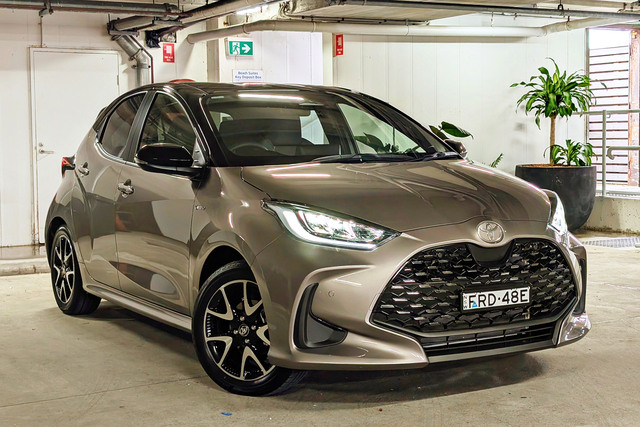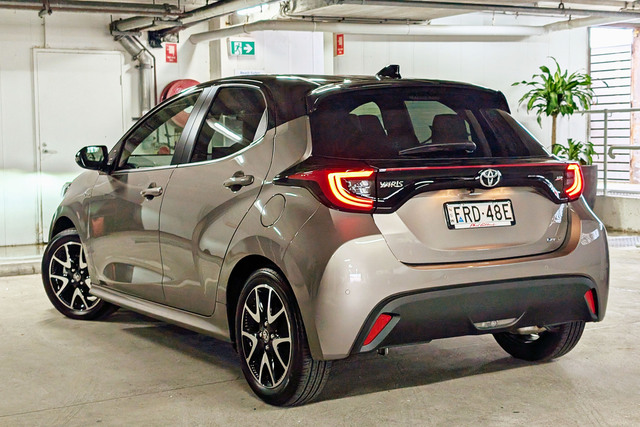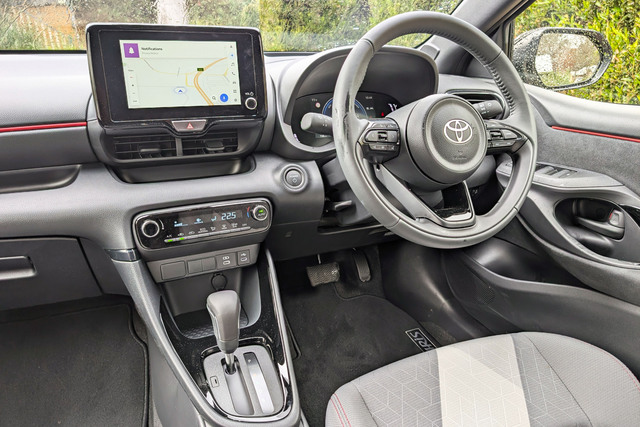Toyota’s small but practical Yaris is often overlooked in the rush to buy larger more powerful models.
But for environmentally conscious buyers the hybrid-powered pocket rocket offers a very real alternative to fully electric vehicles.
The three cylinder hybrid powertrain offers super low fuel consumption and with it incredibly low engine emissions.
In many ways, you could say it is the perfect city car.
STYLING
Yaris has come a long way since the debacle over its name when introduced as the Toyota Echo back in 1999.
It is now one of the most popular cars on the road with more than 360,000 sales over four generations.
There are three grades to choose from: Ascent Sport, SX and ZR – priced from $28,990. SX takes the price to $32,390 while the sporty ZR enters the ledger at $34,590 – all prices before on-road costs.
The high performance, three-door GR Yaris is priced from $55,490.
Premium paint adds $500 and two-tone paint (black roof) is $450.
Yaris Cross is based on the same platform and starts from $31,790 plus on-roads in front-drive form.
All grades apart from the GR are powered by the same three-cylinder hybrid powertrain these days.
The new 1.5-litre three-cylinder powertrain develops more power than its four-cylinder predecessor, while using substantially less fuel and cutting emissions.
In fact, it offers the best fuel economy of any Toyota, using just 3.3 litres of fuel per 100km and producing just 76 grams of CO2 per kilometre.
Standard kit includes cloth trim and manual aircon, 15-inch steel wheels, analogue speedo, built-in navigation, active cruise control, automatic high beam and speed sign recognition.
There’s also LED daytime, tail and stop lights, auto-fold mirrors with LED turn signals, and rear privacy glass.
SX adds 16-inch alloys, climate air, premium steering wheel and shift knob, LED headlights, indicators and rear combination lights, keyless smart entry, smart-start ignition button and soft-touch instrument panel.
Top-of-the-line ZR gains 16-inch alloys, sports front seats, rear spoiler, head-up display, sports front seats as well as Nanoe-X air filtering technology.
SX and ZR feature a 7.0-inch digital instrument cluster.
Auto lights are standard, but the wipers are manual and so is the rear-view mirror – so we discovered.
Toyota seems to have adopted the approach – if it’s not present then best not to mention it.
Yaris is covered by a five-year unlimited kilometre warranty.
INFOTAINMENT
Infotainment comes in the form of an 8.0-inch touchscreen, with Bluetooth, voice recognition, built-in navigation, AM/FM and DAB+ digital radio, wireless Apple CarPlay and Android Auto, along with generic six-speaker audio.
What it doesn’t get is a wireless charge pad.
There are two USB-C ports in the front but none for rear seat passengers.
All grades come with 12 months of access to Toyota Connected Services, including Safety and Security features, Multimedia Connect and Driving Insights – all accessible through the myToyota Connect app.
SAFETY
Yaris gets a five-star rating for safety with eight airbags including a centre airbag for the front.
It has a reversing camera plus sensors that can detect vehicles or pedestrians at intersections when making turns, active cornering assist and a secondary collision braking.
Autonomous emergency braking (Car-to-Car and Vulnerable Road User) as well as lane keep assist (LKA) with lane departure warning (LDW), emergency lane keeping (ELK) and an advanced speed assistance system (SAS) are fitted as standard on all variants.
There are also front and rear parking sensors and a parking support brake system that can warn the driver of objects around the vehicle and even apply the brakes if necessary.
ZR variants gain Blind Spot Monitor, Safe Exit Assist and Rear Cross Traffic Alert.
ENGINES/TRANSMISSIONS
The 1.5-litre three-cylinder powertrain drives the front wheels through a CVT-style, continuously variable automatic transmission.
Operating on the Atkinson Cycle, the petrol engine’s 67kW and 120Nm are supplemented by a 59kW and 141Nm electric motor-generator and a compact lithium-ion battery.
Combined system output is 85kW (combined torque is not stated).
DRIVING
The all-new Yaris is shorter and sits lower than its predecessor, with a longer wheelbase for maximum interior space and stability.
Unlike its predecessor it is available only in five-door hatchback form; the three-door model is reserved for the performance-flagship GR model.
During development of the car, Mr Toyota himself, Akio Toyoda, stepped in to delay the launch of the car for 12 months.
The first draft was initially larger and heavier, which would have made it more expensive, and he wanted the fat trimmed.
A sporty exterior design comprises a prominent cascading grille, longer bonnet, sculpted door panels, dynamic character lines and a shorter rear overhang.
The interior offers an open, spacious and comfortable cabin with ample headroom, a wider centre console and an up-market ambience with combination cloth and pseudo suede trim.
Ascent Sport has an all-black interior; SX gains silver highlights while ZR is distinguished by sporty red inserts.
Stepping from the massive Tundra directly into the diminutive Yaris was a professional challenge.
The new platform permits the driver's seat to be set lower and further back, creating a more engaging driving position and helping to lower the centre of gravity by around 15mm.
The steering wheel is set closer to the driver, with wider tilt and reach adjustment.
It’s reasonably comfortable in front, however there’s virtually no legroom in the back, making Yaris more of a 2+2 proposition.
Electric steering assistance is tuned for a light touch at low speed and a responsive feeling at high speed.
A 270-litre cargo area incorporates a two-level boot floor, while larger items can be accommodated with a 60:40 split-fold rear seat.
A space saver spare is provided in the event of a puncture.
Yaris hybrid can be operated in a fuel-saving Eco mode or more responsive Power mode.
As a full hybrid, it can also operate on electric power alone, which contributes noticeably to its urban-cycle fuel consumption of just 2.8L/100km.
The hybrid transaxle adopts a compact dual-axis structure with the power-control unit installed directly above it, resulting in a small, lightweight system.
The chassis has been engineered to improve dynamic qualities, reduce body roll and improve braking stability and stopping distances.
The revised front MacPherson struts and rear torsion-beam layout includes reduced friction, softer springs and an increase in rear roll stiffness.
The regenerative brakes feature ventilated discs at the front and drums at the rear.
The thrummy three-cylinder engine in combination with the electric motor is surprisingly responsive, but a bit raucous under hard acceleration.
There’s just the one gear, but the B position provides additional engine braking when travelling downhill.
Drive mode select offers a choice of three modes: Standard, Power and Eco. EV mode can also be selected with a different switch.
Power mode is the one you want when there’s someone up your clacker.
Because of its size elbow room is at a premium. This becomes obvious with a drink bottle in the centre cupholder between the front seats, which makes for an awkward combination with the hand brake and driver’s elbow.
Believe it or not ZR even gets head-up display, but of course you can’t see it with polarised sunglasses.
We discovered this by chance when we happened to tilt our head sideways. Until then it had remained invisible.
With a 36-litre tank, Yaris takes standard 91 RON unleaded, with fuel consumption a claimed 3.3L/100km.
We didn’t quite achieve this figure, but 800km at a rate of 4.0L/100km is fairly impressive.
No range anxiety here.
SUMMING UP
Yaris ZR certainly packs a lot into its tiny frame.
It’s attractive, well equipped, does not use much fuel and doesn’t cost much to buy.
If you’re just looking for something to run around town in, what more could you need?
RATINGS
Looks: 7.5
Performance: 7
Safety: 8
Thirst: 8
Practicality: 7.5
Comfort: 7
Tech: 7.5
Value: 8
Overall: 7.6









